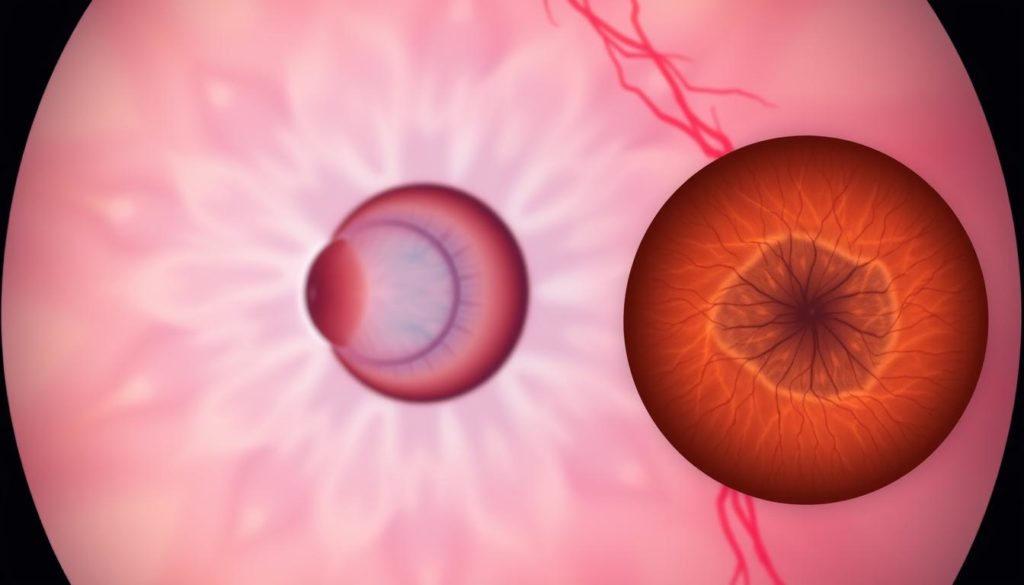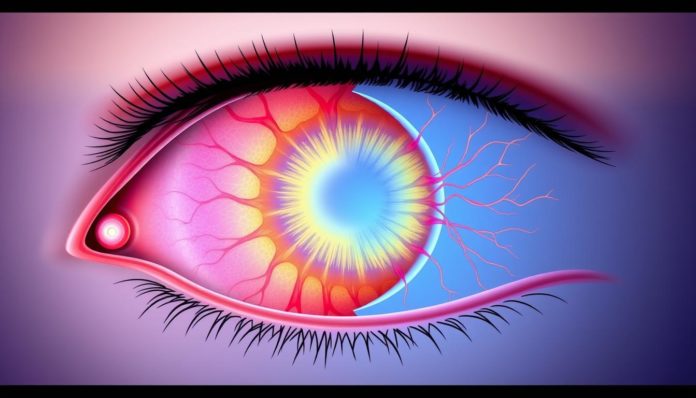“The only thing worse than being blind is having sight but no vision.” – Helen Keller
Welcome to a deeper dive into Morning Glory Syndrome explained. This visual impairment syndrome, also known as a congenital optic disc anomaly, affects many from birth. It poses unique challenges and often requires intricate medical attention.
Through this article, we aim to unravel the complexities surrounding Morning Glory Syndrome. We offer a comprehensive understanding for those affected and their loved ones. Get ready to explore the essentials of this condition, from its definition to the multifaceted aspects of living with it.
What is Morning Glory Syndrome?
Morning Glory Syndrome (MGS) is a rare condition at birth. It shows unique changes in the optic disc. These changes often lead to eye problems and make seeing difficult.

Defining Morning Glory Syndrome
Morning Glory Syndrome, also known as *morning glory disc anomaly*, looks like the morning glory flower. It has a special look because of its structure. This condition has an enlarged and hollowed-out optic disc with odd blood vessel patterns.
Characteristics of Morning Glory Syndrome
Key signs of Morning Glory Syndrome include a big, funnel-shaped *optic nerve malformation*. There’s also white glial tissue in the center and odd retinal vessel arrangements. These traits can cause vision problems but vary in how severe they are.
Historical Background
Morning Glory Syndrome was found in the mid-20th century. It got its name because the optic disc looks like a morning glory flower. Since then, research has grown to understand this rare condition better.
Causes of Morning Glory Syndrome
Morning Glory Syndrome (MGS) is still a mystery in medicine. We don’t know exactly why it happens. But, studies and theories give us clues. They point to a mix of genetic and developmental factors affecting the eye.

Genetic Factors: Some scientists think genetic mutations might cause MGS. These mutations could affect the optic nerve’s development. This leads to the unique look of the optic disc in MGS patients. Even though no single gene is confirmed, research keeps looking for genetic clues.
Developmental Factors: Another idea is that MGS comes from issues during embryonic development. Any problems during this time could lead to a pediatric optic nerve anomaly. These issues might change the optic nerve’s structure and function, causing MGS.
“Understanding the causes of MGS is crucial for advancing diagnosis and treatment strategies. Future research might unravel the complex interplay between genetic and developmental factors, offering clearer answers and more effective interventions.” – Dr. Susan Garcia, Ophthalmology Researcher.
Even with these theories, we still don’t fully understand MGS. Scientists keep studying genetic and developmental factors. They aim to find out exactly how MGS happens. Their goal is to improve early diagnosis and treatment, and maybe even prevent MGS.
Symptoms of Morning Glory Syndrome
People with Morning Glory Syndrome (MGS) often see things differently. This is because of the optic disc pit, a key feature of the condition. This part talks about the common and special symptoms in kids with MGS, showing it’s something they’re born with.
Common Symptoms
Morning Glory Syndrome shows up in many ways. People might notice:
- Blurred or distorted vision in one or both eyes
- Significant vision loss that can range from mild to severe
- Presence of an optic disc pit, leading to a range of retinal abnormalities
- Increased sensitivity to light, often resulting in discomfort
These signs come from the retina and optic nerve being different. The optic disc pit can cause a retinal detachment. This leads to vision getting worse over time. So, people with MGS face many visual challenges, known as visual impairment syndrome.
Symptoms in Pediatric Patients
Since Morning Glory Syndrome is present at birth, symptoms show up early. Kids might have:
- A noticeable difference in visual capacity between the two eyes
- Strabismus (crossed eyes), stemming from uneven visual input
- Nystagmus (involuntary eye movement), especially when the retinal abnormality affects one eye more than the other
- Severe visual impairment syndrome, which can impede normal visual development
It’s important to find and treat these symptoms early in kids. Doctors work hard to lessen the effects of the optic disc pit and other eye problems. They try to keep and improve vision in children.
Diagnosing Morning Glory Syndrome
Diagnosing Morning Glory Syndrome (MGS) requires several steps. Doctors first look for signs like an enlarged, funnel-shaped optic disc. They also check for glial tissue around it.
Imaging tests are key to confirming the diagnosis. MRI and ultrasound give detailed views of the optic disc. These tests help tell MGS apart from other conditions.
Early detection is crucial for managing symptoms and preventing complications. Doctors from different fields work together. They aim for an accurate optic disc anomaly diagnosis. Despite the challenges, thorough checks and early action improve the patient’s life.
Here are some common techniques used:
- Clinical Examinations
- MRI Scans
- Ultrasound Imaging
These methods help doctors make a precise diagnosis. This leads to early and effective treatment plans for each patient.
Treatment and Management Options
Looking into treatment for Morning Glory Syndrome and management of visual impairment means exploring both medical and supportive ways. These are designed to improve life quality for those affected. We’ll look at the different methods available for Morning Glory Syndrome patients.
Medical Interventions
Medical treatments aim to stabilize the condition and manage symptoms. For example:
- Laser Therapy: Helps seal retinal holes and prevent detachment.
- Vitrectomy: Surgery to remove vitreous gel and reduce retina traction.
- Cataract Surgery: Corrects lens opacities that can worsen vision.
These treatments are customized based on each person’s needs and symptoms.
Vision Support and Therapy
Management of visual impairment also includes supportive and rehabilitative steps. These steps aim to make the most of remaining vision and improve daily life.
- Low Vision Aids: Tools like magnifying glasses and telescopic lenses help a lot.
- Vision Therapy: Personalized exercises improve visual skills and coordination.
- Occupational Therapy: Helps adapt to daily tasks and boosts independence.
Here’s a table showing key vision support and therapy options and their benefits:
| Support Option | Description | Benefits |
|---|---|---|
| Low Vision Aids | Devices to enhance visual capacity | Improves reading, navigation, and daily activities |
| Vision Therapy | Exercises to boost visual performance | Enhances eye function and coordination |
| Occupational Therapy | Adaptations for everyday tasks | Increases independence and quality of life |
By using both medical and supportive methods, people with Morning Glory Syndrome can have better outcomes. They can lead more fulfilling lives.
The Role of Genetics in Morning Glory Syndrome
The genetics of Morning Glory Syndrome is key to understanding this complex condition. Scientists are still searching for the exact genetic cause. But, studies suggest a genetic link might exist.
Researchers look closely at optic nerve malformation in patients. They’ve found patterns in family histories. This hints at inherited genetic factors, but more research is needed to be sure.
Genetic testing is getting better. Finding specific genetic markers could lead to predictive testing. This could mean early diagnosis and more tailored treatments.
Genetic counseling is also important. Families with a history of optic nerve malformation can learn about risks. This helps them prepare for what might come.
In short, research into Morning Glory Syndrome’s genetics is uncovering vital information. It’s helping us understand genetic factors. This knowledge is crucial for future medical breakthroughs and better patient care.
Living with Morning Glory Syndrome
Adjusting to life with Morning Glory Syndrome (MGS) means facing unique challenges. It requires a mix of personal adjustments and community support. This approach helps in embracing the changes.
Daily Life and Adaptations
Daily life with MGS demands specific adaptations for visual impairments. Using tools like magnifiers and screen readers helps. Also, adjusting home lighting can make a big difference.
Children and adults can benefit from special educational resources and mobility training. These tools help them do daily tasks on their own. By making these adaptations, people with MGS can live more fulfilling lives.
Support Groups and Resources
Support groups and resources are key for those with Morning Glory Syndrome. Organizations like the American Foundation for the Blind (AFB) offer valuable help. They provide information, peer support, and educational materials.
Connecting with others who share similar experiences can foster a sense of community, offering emotional support and practical advice.
Family members and caregivers should also join these support networks. This ensures everyone gets the support they need. Using these resources can help improve coping strategies and quality of life.
Research and Future Directions
The study of Morning Glory Syndrome is growing fast, thanks to new clinical trials and tech. This rare eye problem needs more research to find better treatments. Scientists are learning more about its causes, which could lead to better care.
Researchers are looking into gene and stem cell therapy for MGS. These methods could fix or replace damaged eye tissues. Also, new imaging tools like high-resolution OCT help doctors diagnose and track MGS better.
The future of treating optic disc anomalies is bright, thanks to medical progress and teamwork. Doctors from different fields must work together to help patients. With ongoing research, we hope to improve lives and futures for those with MGS.
FAQ
What is Morning Glory Syndrome?
Morning Glory Syndrome (MGS) is a rare condition affecting the optic disc. It looks different and can cause vision problems.
What are the characteristics of Morning Glory Syndrome?
MGS has a unique optic nerve head and abnormal blood vessels. It looks like a morning glory flower. This is why it’s called Morning Glory Syndrome.
When was Morning Glory Syndrome first identified?
Doctors first talked about MGS in 1970. They named it after the flower it looks like.
What causes Morning Glory Syndrome?
We don’t know exactly why MGS happens. But it might be linked to how the optic nerve grows in the womb. Scientists are still studying it.
What are common symptoms of Morning Glory Syndrome?
People with MGS often see blurry or have poor vision. In some cases, vision loss can be severe. This can happen in one or both eyes and often starts in childhood.
How do symptoms manifest in pediatric patients?
Kids with MGS might have vision problems from birth. They might have trouble seeing or following objects. Finding and treating it early is very important.
How is Morning Glory Syndrome diagnosed?
Doctors use special exams and tests to find MGS. They look at the optic nerve and retina. MRI or ultrasound might also be used.
What treatment options are available for Morning Glory Syndrome?
There’s no cure for MGS. But doctors can help manage symptoms. They watch for serious problems and help improve vision with therapy.
What role do genetics play in Morning Glory Syndrome?
Research suggests MGS might run in families. Scientists are looking into this. They hope to find out more about genetics and MGS.
How can individuals adapt to living with Morning Glory Syndrome?
People with MGS can use special tools and go to therapy. Making lifestyle changes can also help. Support groups offer help and connection.
What current research is being conducted on Morning Glory Syndrome?
Scientists are trying to understand MGS better. They’re working on better tests and treatments. New studies and technologies offer hope for better care in the future.


